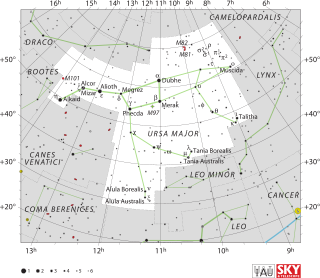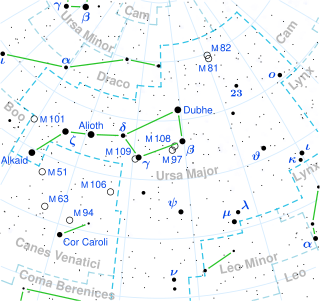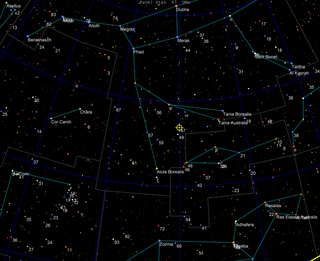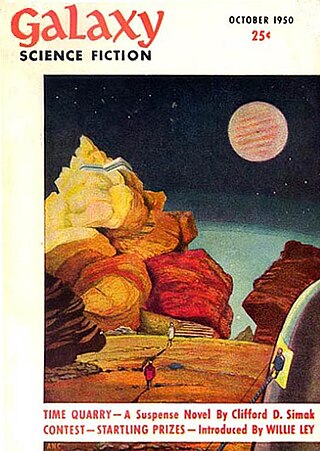Related Research Articles
Known Space is the fictional setting of about a dozen science fiction novels and several collections of short stories by American writer Larry Niven. It has also become a shared universe in the spin-off Man-Kzin Wars anthologies. The Internet Speculative Fiction Database (ISFDB) catalogs all works set in the fictional universe that includes Known Space under the series name Tales of Known Space, which was the title of a 1975 collection of Niven's short stories. The first-published work in the series, which was Niven's first published piece, was "The Coldest Place", in the December 1964 issue of If magazine, edited by Frederik Pohl. This was the first-published work in the 1975 collection.

Ursa Major is a constellation in the northern sky, whose associated mythology likely dates back into prehistory. Its Latin name means "greater bear", referring to and contrasting it with nearby Ursa Minor, the lesser bear. In antiquity, it was one of the original 48 constellations listed by Ptolemy in the 2nd century AD, drawing on earlier works by Greek, Egyptian, Babylonian, and Assyrian astronomers. Today it is the third largest of the 88 modern constellations.

Earthlight is a science fiction novel by British writer Arthur C. Clarke, published in 1955. It is an expansion to novel length of a novella of the same name that he had published four years earlier.

Dubhe, also called Alpha Ursae Majoris, Latinised from α Ursae Majoris, is, despite being designated "α" (alpha), the second-brightest object in the northern constellation of Ursa Major. This prominent asterism is known as the Big Dipper, the Plough, and the Great Bear. Alpha Ursae Majoris is the northern of the 'pointers', the second being Beta Ursae Majoris, or 'Merak' – this pair of stars point towards Polaris, the North Star.

47 Ursae Majoris, formally named Chalawan, is a yellow dwarf star approximately 45.3 light-years from Earth in the constellation of Ursa Major. As of 2011, three extrasolar planets are believed to orbit the star.

Coyote (2002) is a science fiction novel by American writer Allen Steele, the first in a series of eight books. It is a fixup of several of Steele's previously-published short stories, beginning with Stealing Alabama in the January 2001 issue of Asimov's Science Fiction.

Allen Mulherin Steele, Jr. is an American journalist and science fiction author.

70 Virginis b is an extrasolar planet approximately 60 light-years away in the constellation of Virgo. Announced in 1996 by Geoffrey Marcy and R. Paul Butler, 70 Virginis was one of the first stars confirmed to have planets orbiting it. When first announced, 70 Virginis b was considered to be within its star's habitable zone, but it was later confirmed that the planet has an eccentric orbit, closer to its parent.

Mizar is a second-magnitude star in the handle of the Big Dipper asterism in the constellation of Ursa Major. It has the Bayer designation ζ Ursae Majoris. It forms a well-known naked eye double star with the fainter star Alcor, and is itself a quadruple star system. The Mizar and Alcor system lies about 83 light-years away from the Sun, as measured by the Hipparcos astrometry satellite, and is part of the Ursa Major Moving Group.
Iota Ursae Majoris, also named Talitha, is a star system in the northern circumpolar constellation of Ursa Major. It has an apparent visual magnitude of 3.14, making it visible to the naked eye and placing it among the brighter members of this constellation. Based upon parallax measurements, it is located at a distance of 47.3 light-years from the Sun.
Theta Ursae Majoris is a suspected spectroscopic binary star system in the northern circumpolar constellation of Ursa Major. It has an apparent visual magnitude of 3.17, placing it among the brighter members of this constellation. The distance to this star has been measured directly using the parallax method, yielding an estimated value of 43.96 light-years.
Kappa Ursae Majoris is a binary star in the constellation of Ursa Major. With a combined apparent magnitude of +3.60, the system is approximately 358 light-years from Earth.
Xi Ursae Majoris is a star system in the constellation of Ursa Major. It has the traditional name Alula Australis; Xi Ursae Majoris is the Bayer designation, which is Latinised from ξ Ursae Majoris and abbreviated Xi UMa or ξ UMa. It was the first visual double star for which an orbit was calculated, when it was computed by Félix Savary in 1828. It is also a variable star with a small amplitude. Xi Ursae Majoris is found in the left hind paw of the Great Bear.
4 Ursae Majoris (sometimes abbreviated 4 UMa) is the Flamsteed designation of a star in the northern circumpolar constellation of Ursa Major. It also bears the Bayer designation of Pi2 Ursae Majoris (Pi2 UMa, π2 Ursae Majoris, π2 UMa) and is traditionally named Muscida. With an apparent visual magnitude of +4.6, this star is visible from suburban or darker skies based upon the Bortle Dark-Sky Scale. From parallax measurements made during the Hipparcos mission, this star is at a distance of 256 light-years (78 parsecs) from Earth. As of 2011, one extrasolar planet has been confirmed to be orbiting the star.

47 Ursae Majoris b, formally named Taphao Thong, is a gas planet and an extrasolar planet approximately 46 light-years from Earth in the constellation of Ursa Major. The planet was discovered located in a long-period orbit around the star 47 Ursae Majoris in January 1996 and as of 2011 it is the innermost of three known planets in its planetary system. It has a mass at least 2.53 times that of Jupiter.

47 Ursae Majoris c, formally named Taphao Kaew is an extrasolar planet approximately 46 light-years from Earth in the constellation of Ursa Major. The planet was discovered located in a long-period around the star 47 Ursae Majoris. Its orbit lasts 6.55 years and the planet has a mass at least 0.540 times that of Jupiter.
The fictional portrayal of the Solar System has often included planets, moons, and other celestial objects which do not actually exist in reality. Some of these objects were, at one time, seriously considered as hypothetical planets which were either thought to have been observed, or were hypothesized to be orbiting the Sun in order to explain certain celestial phenomena. Often such objects continued to be used in literature long after the hypotheses upon which they were based had been abandoned.

The planetary systems of stars other than the Sun and the Solar System are a staple element in many works of the science fiction genre.
Sigma2 Ursae Majoris is a binary star in the constellation of Ursa Major. Parallax measurements made by the Hipparcos spacecraft put it at a distance of about 66.5 light years from Earth, making this a fairly nearby system. The primary component has an apparent magnitude of about 4.8, meaning it can be seen with the naked eye (see Bortle scale).

65 Ursae Majoris, abbreviated as 65 UMa, is a star system in the constellation of Ursa Major. With a combined apparent magnitude of about 6.5, it is at the limit of human eyesight and is just barely visible to the naked eye in ideal conditions. It is about 760 light years away from Earth.
References
- ↑ Steele, Allen. Coyote. ISBN 9781101208168.